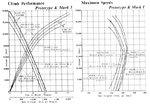Hi.
I am currently doing an assignment on the Hawker Hurricane Mk 1 and am unable to find data on the propeller used.
I am specifically after enough information to perform blade element analysis theory, which will require things such as the rate of twist of the blades, chord lengths.. e.c.t
Im pretty sure this may have been asked before but im having trouble finding a relevant answer among the hundreds of results i get when searching "propeller geometry"
Any information on a propeller with diamater around 11ft will be appriciated, as i do not need the exact same one used, rather i have to find one that will work for it.
Thanks in advance
I am currently doing an assignment on the Hawker Hurricane Mk 1 and am unable to find data on the propeller used.
I am specifically after enough information to perform blade element analysis theory, which will require things such as the rate of twist of the blades, chord lengths.. e.c.t
Im pretty sure this may have been asked before but im having trouble finding a relevant answer among the hundreds of results i get when searching "propeller geometry"
Any information on a propeller with diamater around 11ft will be appriciated, as i do not need the exact same one used, rather i have to find one that will work for it.
Thanks in advance

